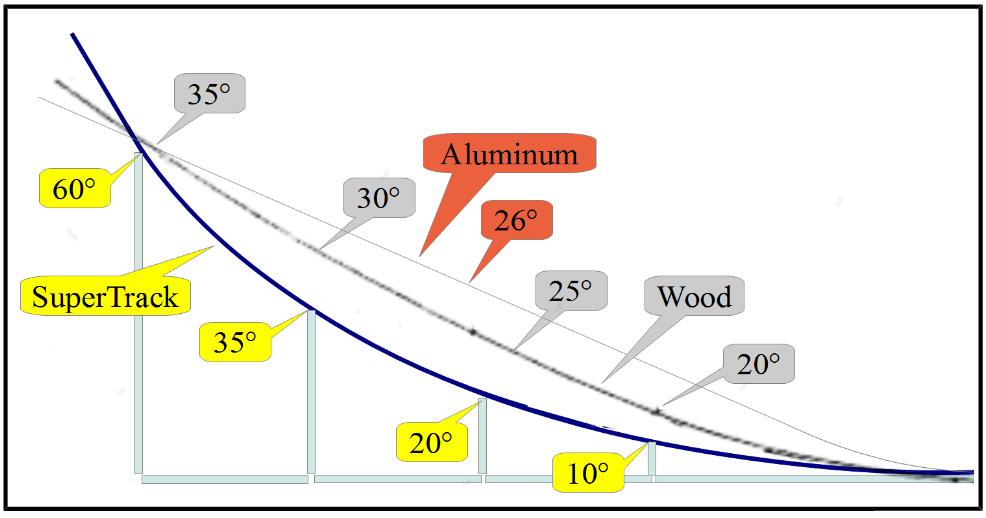Pinewood Derby Track Starting Ramps
All cars compete, at least locally, on the same track. As a result, very little thought is given to the starting ramp slope by users of the track. Pinewood Derby Track designers should give it thought but little is published indicating that they do or did. Here's some insight into what we think matters and why we designed the SuperTrack starting ramp the way we did.
Fundamentally, the starting ramp simply launches the cars down the track. But upon closer inspection one sees a problem at the bottom of the hill. Let's consider two simple but extreme cases.
In an "L" shaped track, (fall to the floor, turn 90°, then go level to the finish) the car accelerates very quickly, gets to the finish the fastest of any design since it carries top speed for essentially the entire race, but there's one heck of a problem at the bottom of the ramp! This illustrates in an extreme way the concept that besides gaining speed the car's front wheels will be pushed up relative to the rear axle in order to get to the flat area of the track. When this happens at speed, inertia causes the front wheels to keep on going up thus making the car unstable. When the cars are heavily rear weighted, a speed trick often used to keep the weight on the hill longer, this instability can cause the front wheels to lift off the ground and fly over the guides making for a spectacular but ultimately unsatisfying result.
In a constant slope "wedge" track the car is going the fastest at the very end of the race. No rotation and therefore no rotational instability exists. In contrast to the "L" shaped track, constant slope tracks are possible and although heavy, expensive to build and cumbersome to store and transport, some do exist.
The problem then becomes defined as accelerating the car while minimizing the rotational instability within a practical Pinewood Derby Track design. Note: Because gravity is the accelerating force and assuming all tracks start at the same height above the floor, all tracks accelerate the car to essentially the same speed at the bottom of the hill. The time it takes the car to get there can vary considerably.
Lets look at the available solutions based on information from the manufacturers' and other web sites.
Pinewood Derby Track Starting Ramp Profiles

Aluminum. Because the aluminum extrusion is essentially rigid, this design uses two constant slopes (starting ramp and runout) and a pre-formed constant radius joining section. As a result the car rotates approximately 26° in a very short time at its fastest speed. Within the commercial market this is the worst case design for maintaining car stability. The center rail guides which channel the air under the car help create lift which further deteriorates the stability.
Wood. This and similar designs, including one non-rigid aluminum design, exist as both home-brew and commercial products and is typical of the plans found online for building your own Pinewood Derby Track. It has a higher initial slope than most aluminum Pinewood Derby tracks which creates a faster initial start. As the car goes faster the amount of slope is decreased linearly so that at its fastest speed the car has only 20° of final rotation over a somewhat longer distance. This is a significant reduction in rotation over the aluminum design, but still substantial. Stability is helped by the lower angle and additionally because the track tends to have a solid center guide spoiling the smooth air flow under the car thus reducing any potential front end lift. As mentioned elsewhere on our site, both center guides and center rail guides tend to have front or back bumper rubbing issues at the bottom of the hill but that is not a part of this discussion.
SuperTrack. The bendable and elastic nature of ABS plastic and the four-point suspension of the starting stand allow SuperTrack to optimize the starting ramp curve for a very fast, very stable launch, yet still return to flat for storage. As the car accelerates the rotational angle decreases exponentially. A starting angle of 60° at zero speed diminishes smoothly to 35° then 20° as the car goes ever faster and finally to just 10° over a significantly extended distance when the car is going its fastest providing the best stability and fastest launch time.
Sometimes simple things and a little thought can make for a better Pinewood Derby Track design.
Click here for more info on SuperTimer II and our RaceManager Software.
Click here to order SuperTrack.
Assembly Information for SuperTrack.

![[SuperTrack]](/track/pinewood_derby_track_tr1c.jpg)
![[SuperTimer II]](/ssi/pinewood_derby_timer_pw.gif)
![[College]](/ssi/college.gif)
![[home]](/ssi/pinewood_derby_home.gif)
